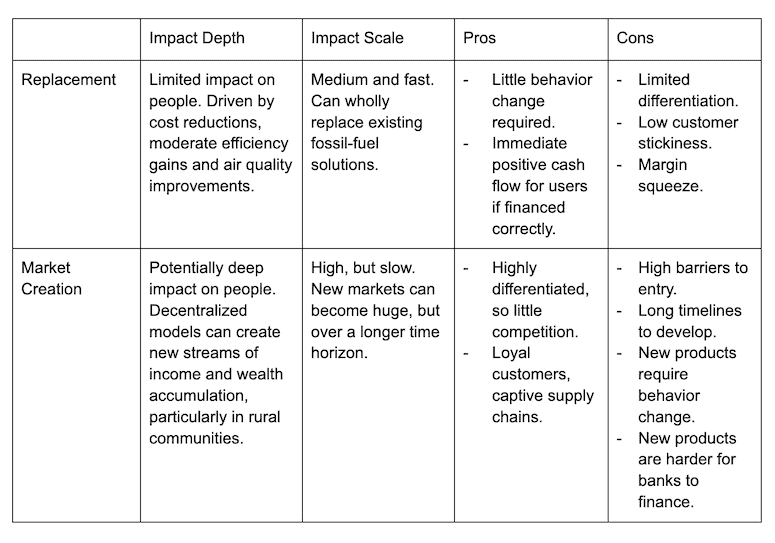Replacing Old Technologies or Creating New Markets?: The Pros and Cons of Two Paths to Impact for Productive Use of Energy
Transformative technologies may start by making us more efficient, but it’s when they are embedded in new business models that they fundamentally change the way that we live and work. For instance, trains began as “faster horses” aiming to displace wagons, and ended up enabling modern industry. The radio was just a “wireless” telegraph until it became the first mass medium, with entire countries listening to a single moment together.
Decentralized renewable energy provides an opportunity to create the same level of disruption as some of these defining inventions from the past century, but we are still in the “faster horses” stage of the sector’s development. Real success will come when we see wholly new models for production and trade built on a vast web of decentralized power systems.
How productive use of energy changes the paradigm
Access to affordable, sustainable energy has consistently been shown to have significant impacts on users’ lives and livelihoods. In particular, technologies and appliances such as solar-powered irrigation, electric motorbikes, and cooling solutions in shops or at the farm gate — often referred to collectively as productive uses of energy (PUE) — have the potential to unlock higher incomes by replacing more costly fuel sources, or by opening new markets and sources of revenue.
The most straightforward case for impact is seen in replacing expensive, dirty technologies, like diesel or petrol-powered pumps and milling machines. This approach saves users money and increases incomes, but may not fundamentally change the nature of their livelihoods. Yet PUE can create even more exciting economic opportunities by moving communities towards an entirely new economic paradigm. Through harnessing new, sustainably powered technologies, companies can build entirely new markets, helping lift rural and low-income communities out of poverty.
For more than eight years Acumen has supported early-stage innovation in PUE. In our work, we have seen a spectrum emerge, with many companies focusing on replacing inefficient technologies — and far fewer looking to develop more disruptive innovations. In this article, we highlight Acumen portfolio companies that provide examples of each approach, explore how these different types of innovations develop and impact their customers, and offer a few ideas for how the global development community can jumpstart disruptive innovation in PUE.
Using Clean Technologies to Replace Inefficiencies
In cities across East Africa, millions of motorbikes play a vital role in keeping people and businesses flowing despite congested streets. However, those bikes rely on petrol, which has meant that riders’ livelihoods are subject to the fluctuating price of oil — and their communities (and the broader climate) suffer the pernicious effects of these vehicles’ high levels of emissions. This scenario represents a perfect opportunity for a sustainable replacement.
To that end, the electric vehicle energy tech startup Ampersand has taken the existing model for motorcycle taxis in East Africa and electrified it. Targeting commercial riders who ferry people and cargo around cities, the company provides electric two-wheelers, batteries, battery management software and a swap station network to rapidly replace depleted batteries. Most riders are easily convinced to switch to these vehicles by the savings on fuel and lower maintenance costs: Ampersand drivers have recorded an estimated 45% increase in their incomes compared to those operating petrol-powered motorcycles. And the company’s electric vehicles release 75% less emissions, contributing to cleaner air and improving community health.
Investors have been quick to support this clear product-market fit, driving a growing interest in the electric mobility space in Africa. E-mobility businesses are well placed to rapidly scale their impact across Africa and beyond over the next few years. The market these companies are addressing is substantial: There are an estimated 27 million registered, mostly petrol-powered motorcycles in Africa, 80% of which are used as passenger taxis or for delivery services. Innovations that aim to replace these inefficient incumbents, such as electric motorbikes, typically provide immediate and tangible benefits. They can be implemented with comparably lower risk to the end users and companies that finance these products: Business continues as usual but is now electrified. Therefore, such innovations can scale rapidly.
Enabling new markets with PUE equipment
There are dozens of existing markets ripe for PUE-powered replacement, and then there are entirely new income streams that PUE innovations will make possible. To take one key example, renewable technology can grow local production and processing by orders of magnitude.
For instance, Resham Sutra is a social enterprise that aims to empower and organize underprivileged rural artisan communities operating in eastern India, including the state of Meghalaya. The area is famous for a particular product: silk. Eri silkworms are native to the region, and are bred for both food and yarn. In years past, you could see people spinning silk from hand reels as they walked home or chatted with friends. But producing yarn this way was time-consuming and difficult work, while the resulting yarn was low in quality. Yet mechanized production was impractical: Local villages are connected to the electric grid, but they typically receive less than five hours of power per day.
Resham Sutra saw an opportunity. They started by developing one of the world’s first solar-powered micro silk reeling and spinning machines, which suited the needs of small-scale artisanal producers. They embedded those machines in a holistic business model that includes inputs, training and asset financing, and provides market linkage through the GramSootra app, bringing all players in the value chain onto a common platform. Today these communities are producing three to five times more silk yarn, in less time, and at a much higher quality.
Resham Sutra’s solar-powered machinery improves production efficiency. However, the real innovation in its business model involves leveraging access to energy to transform low-quality silk production into a more modern, integrated, artisanal industry — while channeling the benefits of this transformation to those who had previously received the smallest share in the value chain. Other competitors have tried to sell similar machines in this market, but the holistic, rooted nature of Resham Sutra’s business makes them difficult to displace.
Comparing the impact and scale of these approaches
The following table outlines the inherent tradeoffs between these approaches:

In summary, “replacement” business models have a faster route to market, but will have more competition unless they can layer on value-added services. “Market creation” business models face higher mountains to climb, but when they get to the top, the air is clearer — the virtue of disruptive market innovation is that you get to own the new market for a considerable time.
At this point in the PUE sector’s growth, we are seeing fewer examples of markets being created. After all, it’s still early in the technology’s development curve. As Chris Dixon, a general partner at Andreessen Horowitz, has articulated, most new technologies find their early niche by doing old things better. But as Dixon points out, “The most common mistake people make when evaluating new technologies is to focus too much on the ‘doing old things better’ category.”
Leveraging clean energy to win the race against poverty
Under the UN Sustainable Development Goals, the world is committed to ending poverty by 2030. For clean energy to reach its potential to contribute to this goal in time, we can’t settle for developing the sector at a leisurely pace. So, how can we shorten development curves, given the dual urgencies of poverty and climate change? We have a few ideas:
- Venture Studios: We need more institutions that can invest in the problem space, instead of just investing in solutions. Venture studios defray the risk and cost of starting companies. The existing venture studios in the PUE space — including SocialAlpha, Enviu and Delta 40 — are doing yeoman’s work. Still, we must grow them and create others that can partner with governments and investors to quickly scale effective solutions. Corporate venture arms could do the same, creating space for large companies to take risks on untested innovations while providing the backing and infrastructure to enable their rapid scale.
- Risk-Tolerant Patient Capital: Disrupting the status quo takes time, iteration and a healthy appetite for risk. The returns can be significant, but the likelihood and timing of success are far from certain. Companies building new markets require more patient capital from investors willing to shoulder their share of the risk. This is the foundation of Acumen’s investment and impact thesis: We believe that guarantees and blended finance, supported by risk-tolerant investors and donors, could help catalyze more investment from investors who want to support new technologies but are limited by risk-return requirements.
- Success-based Finance: For particularly urgent needs like irrigation in Africa, we must rethink success-based finance. Philanthropy has the opportunity to be a significant catalyst. But if we want to solve difficult problems, donors need to offer a much greater financial incentive — to the tune of hundreds of millions of dollars — to unlock real interest and spark new innovation from leading research firms and commercial capital markets. Framing such incentives around outcomes that impact the lives of people rather than outputs (like the number of units of pre-defined technologies deployed) could also help enable innovative solutions that unlock unforeseen markets.
PUE holds excellent promise to displace petrol-powered devices and reduce the need for expensive fossil fuels. However, it also presents an opportunity to create new markets and develop new livelihoods and income sources for hard-to-reach communities. There are tradeoffs between the risk and the depth of impact in these models, but the biggest risk is not acting at all.
Daniel Waldron is Head of Insights, Chris Emmott is the Associate Director of Investing in Energy Access, Yash Vardhan Gaddhyan is a part-time consultant with the Hardest-to-Reach initiative, and Ruth Wairimu is the Manager responsible for the East Africa Education Facility at Acumen.
Photo credit: Johanneke Kroesbergen-Kamps
- Categories
- Energy, Environment, Investing, Technology, Transportation



